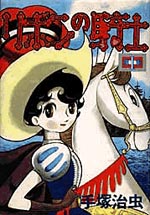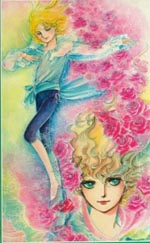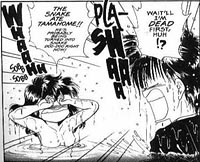
More often than not, my joy in studying various manga stems from the staggering diversity they embody that Western comics did not develop, has not developed or once snuffed out thoughtlessly in a vain attempt to please hypothetical censors.
Another, perhaps less cynical, way of phrasing it might be that manga, which developed largely separate from Western comics' social and economic influence, can provide answers to "What if?" questions that it otherwise might be pointless to ask.
Like, "What if, beginning in the late 1950s, American comics publishers had not decided that women, both as creators and as a potential audience, had the cooties?"
Instead of launching into a complicated, largely academic discussion about gender dialectic and such, we only need look towards Japan with our Occidental telescope and say, "Shojo".
 While early Japanese comic strips (as opposed to bona fide modern manga) of interest to girls and women had been made before his time, most manga scholars agree that shojo manga begins, unsurprisingly, with Osamu Tezuka. In 1953, Tezuka applied his newly invented long-story comics techniques to the task of entertaining young girls with a series called RIBON NO KISHI (PRINCESS KNIGHT) with great success.
While early Japanese comic strips (as opposed to bona fide modern manga) of interest to girls and women had been made before his time, most manga scholars agree that shojo manga begins, unsurprisingly, with Osamu Tezuka. In 1953, Tezuka applied his newly invented long-story comics techniques to the task of entertaining young girls with a series called RIBON NO KISHI (PRINCESS KNIGHT) with great success.
Before that point, girls' magazines were populated largely by illustrated romance novelettes, but the success of this strip encouraged other artists to seek this demographic and the first generation of shojo manga were born. While most of their creator/artists were males who got their start doing shojo before graduating up to the shonen (boys) magazines, a few women mangaka appeared during this Golden Era of shojo, including Masako Watanabe, Toshiko Ueda, and Hideko Mizuno.
In 1959, Kodansha introduced the first weekly manga magazine, SHONEN MAGAZINE, and the effect was electrifying throughout the industry, but, as it would turn out, would prove doubly so for the future of shojo. With the deadline coming around four times more often, most of the male artists drawing shojo stopped to focus on the bigger paying accounts at the boys' magazines, leaving a hungry audience of girls to be better served by artists of their own gender.
'What if American comics publishers had not decided that women had the cooties?' By 1966, no less than seven weekly comic magazines were hitting the Japanese news-stand, five dedicated to boys and two for the girls. Within the pages of magazines like SHOJO FRIEND and MARGARET, female artists developed the precursor of what we recognise today as modern shojo by twisting the manga forms left behind by their largely male predecessors into shapes clearly distinguished from a shonen manga aesthetic and distinctly their own.
The linear, largely plot-driven adventure stories pioneered by Tezuka gave way to more contemplative styles of storytelling that, not surprisingly, emphasised mood over action and emotional conflict (and resolution) over violence. In addition, these early shojo pioneers set simple, yet unmistakably shojo tropes into motion, by placing the stories in foreign and exotic locales and populating them with characters that were largely not Japanese.
While most of the genres available to shonen manga readers were still present, at least in their essence, the method and, indeed, even the purpose of manga was completely altered by this sudden and unabashed expression of femininity into the most popular of Japanese media.
Frederik Schodt, author of MANGA! MANGA! THE WORLD OFJAPANESE COMICS (he was persuaded to add the sub-header by his original publishers, who feared being next to 'Manganese' in the card catalogue), looked back on this period from the early 1980s and remarked;
 "With this kind of motivation, other women artists such as Riyoko Ikeda, Moto Hagio, Yumiko Oshima and Keiko Takemiya debuted and began consolidating the gains of their older sisters. These exceptionally talented women, and many others, are the stars of the industry today. They are wealthy; their female fans are fanatically devoted; they are respected in society-at-large; and they are given almost total creative control."
"With this kind of motivation, other women artists such as Riyoko Ikeda, Moto Hagio, Yumiko Oshima and Keiko Takemiya debuted and began consolidating the gains of their older sisters. These exceptionally talented women, and many others, are the stars of the industry today. They are wealthy; their female fans are fanatically devoted; they are respected in society-at-large; and they are given almost total creative control."
Moving out of the late 1960s and into the early 1970s, the manga industry as a whole began to grow more sophisticated as the generation, of both genders, that grew up reading outstanding manga in their childhood largely refused to give them up and demanded that their favourite titles (or at least the artists that drew them) continue to evolve along with them. For shojo, this meant new freedoms in dealing with sexual content, though the prevailing aesthetic was still one of delicacy, meaning that there was a lot of visual suggestion as opposed to direct representation of the sex act itself.
When given the freedoms to discuss and utilise sexual themes in their work, some chose to reinforce those values already existing within the manga (and, consequently, Japanese) culture. Magnifying the earlier, simpler themes of romance, a generation of women's manga (redissu komikku) coalesced around themes of marital discontent, passionate affairs, and a variety of issues of importance to Japanese women as related to family life, including abortion, birth-control, promiscuity and divorce. Others, however, took a more unexpected path that has resulted in what is known as shonen-ai or occasionally as bishonen manga. Shonen-Ai, while sharing many characteristics both visual and narrative with other shojo, focuses primarily on the love between men (and/or boys) as its primary romantic tension.
'Moving out of the late 1960s, shojo manga found new freedoms in dealing with sexual content.' It is important to point out that while shonen-ai manga may have homoerotic themes in them, they are not, in their essential function, works of pornography. In fact, one of the most popular shonen-ai manga, BANANA FISH (available in English from Viz/Pulp), goes on for dozens of volumes without any act of sexual contact between the two male protagonists, Keiichi and Ash. This palpable sense of delicacy, while not applicable to all manga made by women, is still one of the central tenets of shojo manga and in place more often than not.
Given the immense popularity of this type of shojo, it might leave the casual Western observer wondering if millions of Japanese women are secretly fantasising about their husbands making love to other men. While not having a direct line into the psyche of Japanese women, it is my opinion that perhaps shonen-ai manga merely represents a sacred space for its creators and fans, where the masculine/patriarchal value system simply does not apply and they defend that space with the poison pill of "gay-ness" (these are straight men we are talking about repelling, don't laugh!), thereby repelling potentially intrusive husbands and sons who would see such images and storylines as obviously not for them.
In the 1980s, however, it became increasingly common for men to read various shojo magazines, just as girls had probably been reading shonen manga all along. Among the more immediate converts were, of course, the paedophiles, who longed to look at pictures of little girls. Eventually, however, the softened aesthetic of shojo manga, in comparison to the increasingly testosterone-addled men's market that had undergone similar 'sophistications' during the 1970s, appealed to men more in tune with the progressively more-balanced gender climate in Japan.
Adding fuel to this trend, dipping weekly magazine sales in the early 1990s, in step with Japan's receding economy, placed pressure on many women to create stories that appealed more to men and/or boys, to broaden the demographic appeal and increase readership - in some cases, to great success. In fact, a good deal of the shojo manga that are available in English represent this less gender-distinct modern form that subtly offers lines of appeal to various manga audiences that might otherwise scorn it.
 Of particular note is the works of Yu Watase, best known in Anglophonic waters for series like FUSHIGI YUGI and CERES. While some of the expected elements in CERES, in particular, are involved (a blond haired, blue eyed female protagonist finds herself, upon maturation, heir to a great power and an unwanted curse), the story itself displays curious affectations of shonen manga, including a greater dependence on violent conflict for plot mobility, vengeance as a central plot theme, and, occasionally, fan service. ("Aya, why don't you go take a bath and collect your thoughts.")
Of particular note is the works of Yu Watase, best known in Anglophonic waters for series like FUSHIGI YUGI and CERES. While some of the expected elements in CERES, in particular, are involved (a blond haired, blue eyed female protagonist finds herself, upon maturation, heir to a great power and an unwanted curse), the story itself displays curious affectations of shonen manga, including a greater dependence on violent conflict for plot mobility, vengeance as a central plot theme, and, occasionally, fan service. ("Aya, why don't you go take a bath and collect your thoughts.")
Still, CERES is a pretty damn compelling manga, and masterfully drawn by Watase, who pays deference to all of her influences, male and female alike, in her artwork. In this capacity, she represents ably a new generation of female manga artists who have synthesised the lessons of all (or at least large portions of) the manga that came before them.
Despite market pressures otherwise, there is still tons of shojo manga available in English that holds women's values, into whatever form they evolve, most dear. Miwa Ueda's PEACH GIRL [Mixx/TokyoPop] is a vibrant example of contemporary shojo manga, echoing in principle the romantic epics of the 1960s, but bearing a sharp, ultra-modern visual edge and sensibility.
Also of note is Mizuno Junko's work, CINDERALLA, soon to be released in collected form from Viz/Pulp, that takes the shojo form itself and mutates it into a futuristic, visually hyper-femininised shape that must be seen to have its subversive depravity truly felt.
As evidenced by this show of diversity, shojo manga today represent not a genre but a continuum of women's involvement with manga. It is a term that has grown so broad in the four decades now that Japanese women have been creating manga of their own that it is not so much descriptive as it is inclusive, thus making the legacy of shojo manga so much the richer for the complexity of its vital body of work.
Which returns us back to my original question, "What if the American comics industry hadn't decided forty years ago to alienate women, as readers and creators alike?"
As the chain stores all over the world fill up with shojo manga like SAILOR MOON, PEACH GIRL, and CARDCAPTOR SAKURA; as consumers worldwide shell out millions of dollars for anime DVDs based on of these properties; as, for the first time, American girls learn that, somewhere across the ocean, a Japanese woman sits drawing, capable, wealthy, imaginative, making a product for them that no American company can be bothered to; my response to that question is, "It's best not to dwell on things we can't change now."

This article is Ideological Freeware. The author grants permission for its reproduction and redistribution by private individuals on condition that the author and source of the article are clearly shown, no charge is made, and the whole article is reproduced intact, including this notice.


